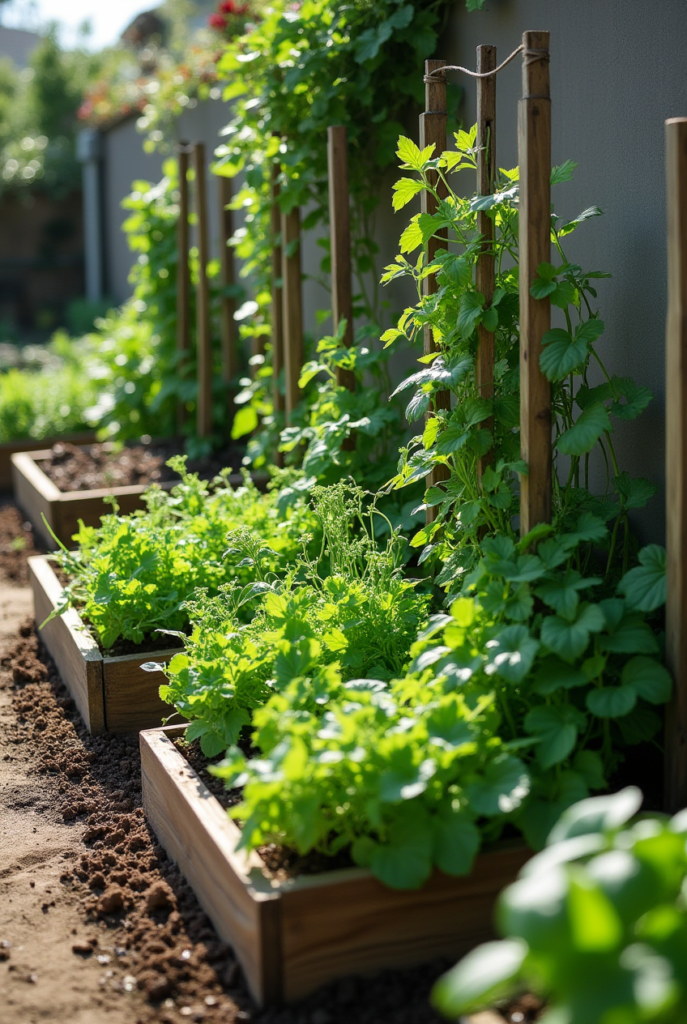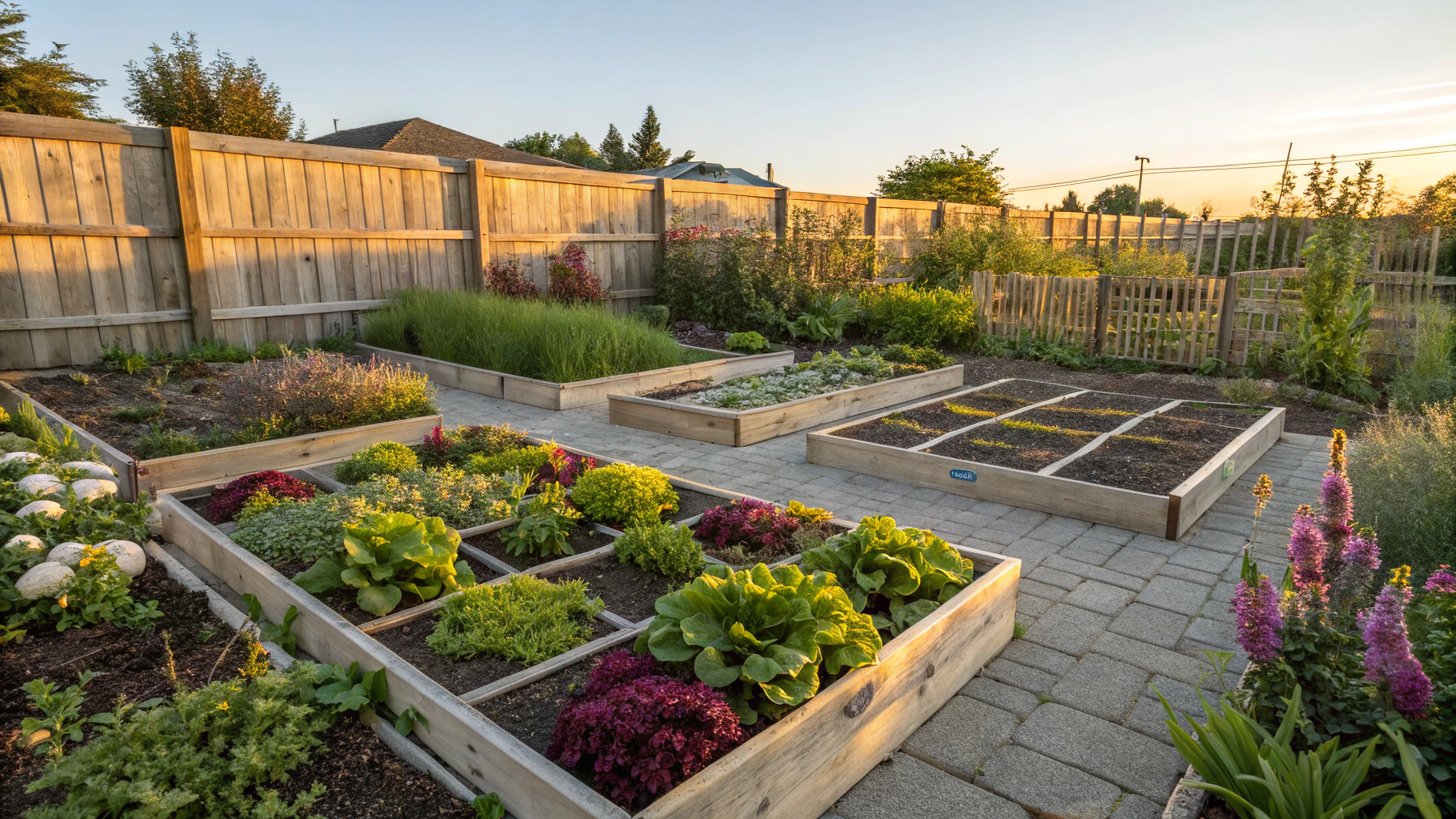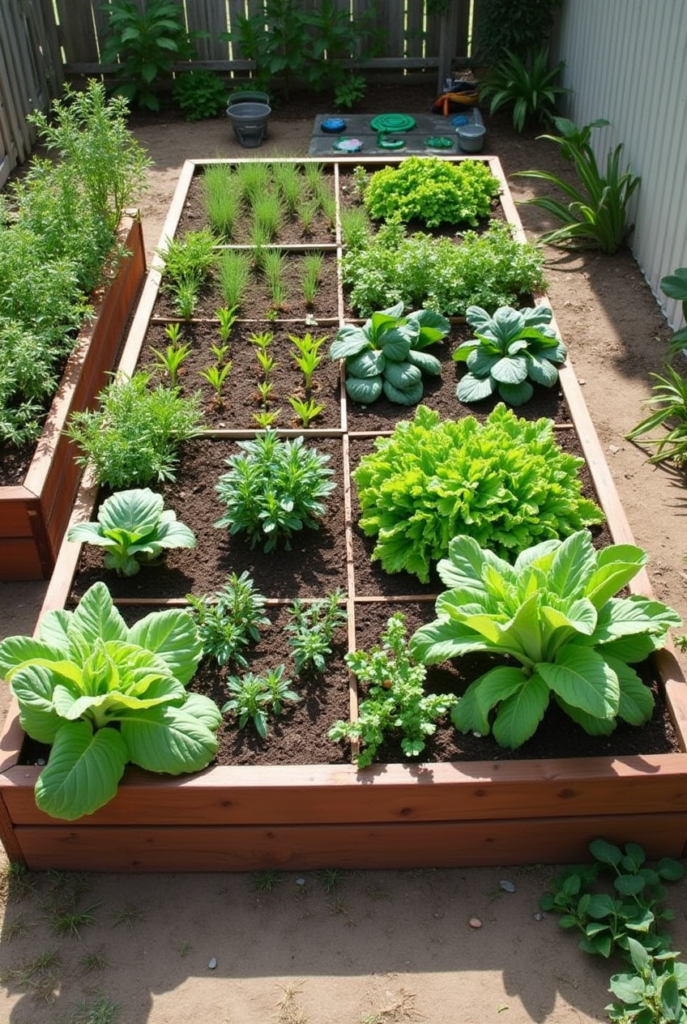Are you tired of spending hours tending to a sprawling garden that gives disappointing yields? I was too, until I discovered square foot gardening layout. The first time I harvested a full salad from just one square foot of my garden, I was hooked. This revolutionary gardening method transformed my relationship with growing food, and I’m confident it can do the same for you.
Square foot gardening isn’t just a technique—it’s a garden revolution that puts abundance within reach for anyone, regardless of space or experience. In this comprehensive guide, I’ll walk you through everything you need to know to create a thriving square-foot garden that maximizes harvests while minimizing effort.
TABLE OF CONTENTS
What is Square Foot Gardening?
Square foot gardening is a simple, efficient, and productive gardening method developed by Mel Bartholomew in the 1980s. Instead of planting in traditional rows, this approach divides the growing area into 1-foot by 1-foot squares, with each square dedicated to a specific crop or plant variety. This grid system allows for intensive planting, efficient use of space, and remarkably high yields.
Core Principles of Square Foot Gardening:
- Raised beds (typically 4’×4′) divided into 1’×1′ squares
- Special soil mix called “Mel’s Mix” (⅓ compost, ⅓ vermiculite, ⅓ peat moss)
- Grid system that organizes planting spaces
- Intensive planting according to specific density guidelines
- Vertical growing for vining plants to maximize space
- Succession planting to ensure continuous harvests
By focusing on high-density planting in small, manageable spaces, square foot gardening can produce up to 5 times more harvest per square foot than traditional row gardening. This approach is perfect for urban gardeners, beginners, and anyone looking to maximize their vegetable production with minimal space and effort.
Benefits of Square Foot Gardening Layouts
Before diving into layouts, let’s understand why this method has gained such popularity:
| Benefit | Description |
|---|---|
| Space Efficiency | Grows significantly more in less space through intensive planting |
| Higher Yields | Produces up to 5x more vegetables than traditional row gardens |
| Water Conservation | Requires about 20% of the water used in conventional gardens |
| Reduced Maintenance | Less weeding, easier plant management, and simplified gardening |
| Extended Growing Season | Raised beds warm faster in spring and allow for succession planting |
| Accessibility | Perfect for people with limited mobility or physical restrictions |
| Beginner Friendly | Simple, systematic approach makes gardening less overwhelming |
I’ve personally seen these benefits in action. My small 4×8 foot square foot garden provides enough vegetables for most of our family’s needs during the growing season, while requiring just minutes of maintenance each week.
Planning Your Square Foot Garden Layout
Step 1: Choose the Right Location
The foundation of a successful square foot garden starts with location:
- Sunlight: Select a spot receiving 6-8 hours of direct sunlight daily
- Accessibility: Ensure your garden is easily reachable for maintenance and harvesting
- Water source: Position near a water source for convenient irrigation
- Level ground: Choose relatively level terrain or be prepared to level it
- Protection: Consider protection from strong winds and potential pests
Pro tip: Track sunlight patterns across your yard for a few days before deciding. Even in seemingly sunny areas, trees or buildings can cast unexpected shadows during different parts of the day.
Step 2: Determine the Size and Number of Beds
The classic square foot garden is 4’×4′, containing 16 square feet:
- Reach: Beds should be no wider than 4′ to reach the center without stepping in
- Length: While 4′ is standard, beds can be longer (4’×6′ or 4’×8′)
- Multiple beds: Consider multiple 4’×4′ beds rather than one large bed
- Walkways: Leave 2-3 feet between beds for easy access
Size calculation guidance:
- For 1-2 people: Start with one 4’×4′ bed (16 square feet)
- For 3-4 people: Two 4’×4′ beds or one 4’×8′ bed (32 square feet)
- For a family of 5+: Three or more 4’×4′ beds (48+ square feet)
Step 3: Design Your Grid Layout
The grid is the defining feature of square foot gardening. Here’s how to plan it:
- Draw your beds: Sketch your garden beds on paper
- Create the grid: Divide each bed into 1’×1′ squares
- Plan plant placement: Assign specific plants to each square based on plant spacing requirements:
- Extra-small plants (1″ spacing): 16 per square foot (carrots, radishes)
- Small plants (4″ spacing): 9 per square foot (beets, onions)
- Medium plants (6″ spacing): 4 per square foot (lettuce, swiss chard)
- Large plants (12″ spacing): 1 per square foot (cabbage, peppers)
- Extra-large plants: 1 plant per multiple squares (zucchini, tomatoes)
5 Optimal Square Foot Gardening Layout Designs
1. The Classic 4’×4′ Beginner Layout
This traditional layout is perfect for first-timers:
| Tomato | Cucumber | Zucchini | Lettuces |
| Carrots | Onions | Spinach | Kale |
| Peppers | Basil | Cilantro | Chives |
| Radish | Beets | Bush Beans | Flowers |
Key features:
- One square for taller plants with trellises (tomatoes, cucumbers)
- Mix of quick-growing and longer-season vegetables
- Companion planting principles applied (basil near tomatoes)
- Includes herbs and flowers for pollinators
- Simple layout ideal for learning the system
2. The Salad Lover’s Layout
If fresh salads are your priority, this layout maximizes leafy greens:
Key features:
- 50% dedicated to leafy greens with succession planting
- Quick-growing root vegetables for salad toppings
- Herbs that complement salad flavors
- Nasturtiums provide edible flowers for garnishes
- Vertical elements (cucumber, tomato) with trellises
3. The Three-Season Layout
This design maximizes harvests across spring, summer, and fall:
| Peas (S→) | Peas (S→) | Spinach (S) | Lettuce (S) |
| →Tomato | →Tomato | →Basil | →Eggplant |
| Radish (S→) | Carrots (S) | Beets (S→) | Arugula (S→) |
| →Peppers | →Summer Sq | →Cucumbers | →Zucchini |
| Tomatoes | Beans | Turnips (F) | Chard |
| Peppers | Onions | Kale (F) | Broccoli (F) |
Key features:
- S→ indicates spring crops followed by summer crops
- F indicates fall crops
- Succession planting maximizes productivity
- Spring greens give way to summer vegetables
- Heat-tolerant plants for summer
- Cold-tolerant vegetables for extended fall harvest
4. The Kitchen Herb Garden Layout
Perfect for culinary enthusiasts:
| Rosemary | Thyme | Oregano | Sage |
| Basil | Cilantro | Parsley | Dill |
| Chives | Mint | Lemon Balm | Tarragon |
| Calendula | Lavender | Nasturtium | Chamomile |
Key features:
- Perennial herbs grouped together (top row)
- Annual herbs that need regular replanting (middle rows)
- Edible flowers in the bottom row
- Mint contained in its own square to prevent spreading
- Common kitchen herbs positioned for easy access
5. The Vertical Maximizer Layout
This layout takes advantage of vertical space for maximum production:
| Trellis↑ | Trellis↑ | Trellis↑ | Trellis↑ |
| Peas | Beans | Cucumbers | Tomatoes |
| Lettuce | Spinach | Chard | Kale |
| Carrots | Radish | Beets | Turnips |
| Onions | Garlic | Basil | Cilantro |
Key features:
- North side dedicated to trellised crops
- Shade-tolerant plants positioned where taller plants cast afternoon shadows
- Root vegetables in easily accessible areas
- Herbs positioned for convenient harvesting
- Maximizes vertical growing potential for small spaces

Creating and Implementing Your Grid System
The grid is what makes a square foot garden work. Here’s how to create it:
Materials for Grid Making:
- Thin wood lath (¼” thick)
- Nylon cord or string
- Small nails or screws
- Zip ties (if using PVC pipe grid)
- Measuring tape and pencil
Step-by-Step Grid Creation:
- Measure and mark 1-foot intervals along all edges of your bed
- Attach thin strips of wood or string at these marks to create a grid
- Ensure your grid is securely fastened but removable for soil amendments
- Label each square (optional) for planning purposes
Pro tip: I prefer using nylon cord for my grids as it’s durable yet flexible, allowing me to remove sections temporarily when harvesting larger plants.
Seasonal Care and Maintenance Tips
Spring Tasks:
- Check bed structures for winter damage
- Replenish soil mix as needed (beds settle over time)
- Add fresh compost to each square
- Reinstall grid system if removed for winter
- Plan and start your spring planting schedule
Summer Tasks:
- Monitor irrigation needs closely (raised beds dry quicker)
- Harvest regularly to encourage production
- Practice succession planting as spring crops finish
- Add light organic mulch to conserve moisture
- Check trellises and supports for stability
Fall Tasks:
- Plant cold-hardy crops for fall/winter harvest
- Consider adding season extenders (row covers, cloches)
- Remove spent plants promptly
- Add compost to vacated squares for next season
- Plan for cover crops in areas that will remain empty
Winter Tasks:
- Protect beds with mulch or cover crops
- Plan next year’s layout on paper
- Consider season extension methods for winter harvests
- Repair or build new beds and trellises
- Order seeds for the coming season
Companion Planting in Square Foot Gardens
Square foot gardening lends itself perfectly to companion planting. Here are some proven combinations:
| Center Plant | Beneficial Companions |
|---|---|
| Tomatoes | Basil, marigolds, nasturtiums, onions |
| Cucumbers | Nasturtiums, marigolds, sunflowers, radish |
| Lettuce | Carrots, radishes, strawberries, onions |
| Beans | Carrots, cucumbers, cauliflower, potatoes |
| Carrots | Sage, rosemary, beans, tomatoes |
Remember to consider the mature size of plants when planning companions. In some cases, quick-growing companions like radishes can be harvested before the main crop needs the full space.
Common Challenges and Solutions
Even with an efficient system, challenges arise. Here’s how to address them:
Limited Sunlight
Problem: Garden area receives less than 6 hours of sun daily.
Solution: Focus on shade-tolerant crops like lettuces, greens, herbs, and root vegetables in areas with 4-6 hours of sun. Consider vertical gardening to maximize light exposure.
Pest Issues
Problem: Insects damaging crops.
Solution: Implement companion planting with pest-repelling plants like marigolds and nasturtiums. Use floating row covers for vulnerable crops. Practice integrated pest management with regular monitoring.
Overcrowding
Problem: Plants becoming stunted due to competition.
Solution: Strictly follow spacing guidelines for square foot gardening. Don’t be tempted to add “just one more” plant per square. Thin seedlings promptly.
Watering Challenges
Problem: Uneven watering or drought stress.
Solution: Install drip irrigation or soaker hoses. Consider olla irrigation for consistent moisture. Add light mulch to conserve water. Water deeply rather than frequently.
Soil Depletion
Problem: Declining yields due to nutrient depletion.
Solution: Add compost to each square after harvesting. Consider crop rotation across squares. Use organic fertilizers specific to plant needs. Complete soil refresh every 3-5 years.
Advanced Square Foot Gardening Techniques
Once you’ve mastered the basics, try these advanced methods:
1. Vertical Integration
Take your garden into the third dimension by incorporating:
- A-frame trellises for cucumbers and melons
- Wall-mounted planters for herbs and greens
- Cattle panel arches spanning across beds
- Hanging containers for trailing crops
2. Season Extension
Extend your growing season with:
- Cold frames built to fit exactly over squares
- Individual cloches for frost-sensitive plants
- Hoop houses that cover entire 4’×4′ beds
- Thermal mass (water jugs) within beds to moderate temperatures
3. Automatic Irrigation Systems
Save time and improve results with:
- Grid-specific drip irrigation systems
- Programmable timers for consistent watering
- Moisture sensors to prevent over/under watering
- Wicking bed modifications for self-watering capabilities
4. Square Foot Perennial Integration
Incorporate perennials strategically:
- Dedicate specific beds to perennial crops
- Include strawberries, asparagus, and herbs
- Create pollinator squares with perennial flowers
- Design perennial borders around annual beds
For more gardening tips follow us on Pinterest.
Conclusion
The square foot gardening layout isn’t just a gardening method—it’s a revolution in how we think about growing food. By focusing on efficient spacing, thoughtful planning, and intensive planting, even the smallest spaces can produce abundant harvests.
I’ve seen firsthand how this approach transforms gardening from a time-consuming chore into an accessible joy. My own square foot garden has become the most productive part of our property, providing fresh vegetables with minimal effort.
Whether you’re a beginner intimidated by traditional gardening or an experienced grower looking to maximize efficiency, the square foot method offers a structured, systematic approach that delivers results. Start with one simple bed, apply the principles outlined in this guide, and watch as your garden becomes a testament to what’s possible when we garden smarter, not harder.
FAQ About Square Foot Gardening Layout
How deep should a square foot gardening bed be?
For most vegetables, a depth of 6-8 inches is sufficient. However, for root vegetables like carrots or parsnips, 10-12 inches is better. If you’re placing your garden on concrete or poor soil, aim for 12 inches of depth to ensure adequate root development.
Can I use square foot gardening layout principles in containers?
Absolutely! The square foot gardening layout works wonderfully in containers. Simply apply the same plant spacing guidelines to appropriately sized containers. A typical 12-inch container can be treated as one square foot, while larger containers can be mentally divided into square foot sections.
How do I plan crop rotation in a square foot gardening layout?
Rather than rotating entire beds, rotate by plant family within your squares. Keep track of what was planted in each square and avoid planting members of the same family (like tomatoes, peppers, and eggplants) in the same square for at least 2-3 years to prevent disease buildup.
Do I need to replace the soil in my square foot garden every year?
No, you don’t need to replace all the soil annually. Instead, add 1-2 inches of compost to each square after harvesting crops. A complete soil refresh is typically only needed every 3-5 years when you notice declining productivity despite regular compost additions.
How do I adapt square foot gardening layout for physical limitations?
Raise the beds higher (24-36 inches) to eliminate bending. Create wider paths between beds (3-4 feet) for wheelchair access. Consider tabletop gardens at 30-36 inches height. Use lightweight tools with ergonomic handles, and incorporate a sitting area near the garden for rest breaks.
What’s the best way to map and track plantings in my square foot garden?
Create a reusable grid template on paper or digitally. Use plant markers or labels in the garden itself. Take photos throughout the season as a visual record. Consider a garden journal with layout diagrams. Digital gardening apps that allow square foot planning can be extremely helpful.
Ready to get started? Grab your measuring tape, sketch your perfect layout, and prepare to be amazed by just how much abundance can come from such a small, well-organized space. Happy gardening!

